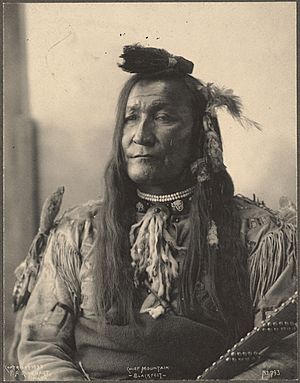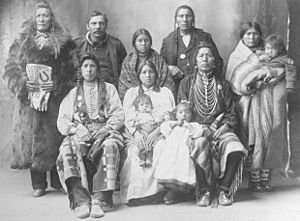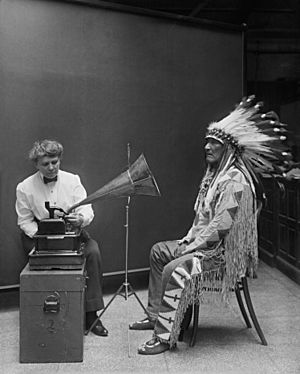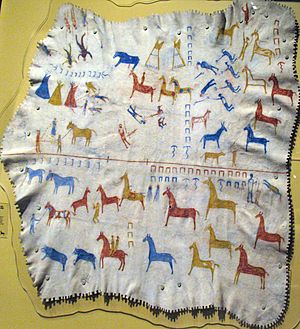Mountain Chief facts for kids
Quick facts for kids
Mountain Chief
|
|
|---|---|
| Ninna-stako | |

Mountain Chief at the Indian Congress of 1898
|
|
| Born | c. 1848 |
| Died | February 2, 1942 (aged 94) |
| Resting place | Browning, Montana |
| Spouse(s) | Bird Sailing This Way; Fine Stealing Woman; Hates To Stay Alone; Gun Woman For Nothing |
| Parents |
|
Mountain Chief (whose name was Ninna-stako in the Blackfoot language) was an important leader and warrior of the South Piegan people. He was born around 1848 and lived until February 2, 1942. He was also known as Big Brave and later adopted the name Frank Mountain Chief. Mountain Chief played a role in the 1870 Marias Massacre, signed the Treaty of Fort Laramie in 1868, and helped researchers understand traditional songs.
Contents
Early Life and Heritage
Mountain Chief was born around 1848 near the Oldman River in Alberta, Canada. At that time, this area was known as British North America. His father was also named Mountain Chief, and his mother was Charging Across Quartering. His father was a respected chief of the South Piegan people. Mountain Chief himself inherited the leadership of the Fast Buffalo Horse band.
He belonged to the Piegan (South Piegan) tribe, which is part of the larger Blackfoot Confederacy. Mountain Chief lived on the Blackfeet Indian Reservation in Montana. His family had a long history of leadership; his father became a chief around 1806.
As a child, Mountain Chief received a special horse from his father. He learned to hunt birds and prairie dogs with arrows. His grandfather, Big Smoke, made his first hunting bow. When he was older, he became a skilled rider and began hunting buffalo with steel-tipped arrows. At 15, he joined his first war party and was given his war name, Big Brave. He used this name during his teenage years because his father was also called Mountain Chief.
Mountain Chief had several half-siblings. He was married multiple times and had several children. His Blackfoot name, “Ninna-stako,” means “Chief Mountain.” This is also the name of a famous mountain in Glacier National Park. His father, the first to hold the name Mountain Chief, passed away in 1872.
The Marias (Baker) Massacre
In the late 1860s, Mountain Chief and other Piegan leaders tried to stop their people from trading with white whiskey traders. These traders often caused problems.
The Marias Massacre happened on January 23, 1870, near the Marias River. About 200 Piegan people from Chief Heavy Runner's band were killed. This event made the already difficult relationship between the Blackfoot Confederacy and white settlers in Montana even worse.
The massacre began after Mountain Chief's half-brother, Owl Child, stole horses from a white ranch owner named Malcolm Clarke. Clarke tracked Owl Child down and humiliated him. In response, Owl Child and a group of Piegan warriors killed Malcolm Clarke in August 1869. All five warriors involved were from Mountain Chief's band. At that time, Mountain Chief was a main chief of the Piegan people.
To punish those involved and prevent more raids, General Philip Sheridan sent cavalry led by Major Eugene Baker. Baker's troops were ordered to target Mountain Chief's band. However, when Baker's forces reached the Marias River, they mistakenly attacked Chief Heavy Runner's camp instead. This camp was suffering from a smallpox outbreak. Mountain Chief and his band had been warned and had already moved to safety in Canada.
Chief Heavy Runner tried to show the soldiers a paper proving he was a friend of the U.S. Army. But an Army scout shot and killed him. The soldiers then attacked the camp, killing many Piegan people. Those who survived were left without clothing, food, or horses, and many died from the cold. Mountain Chief had close family ties to Heavy Runner's camp.
General William Tecumseh Sherman faced criticism for the massacre. He claimed that most of those killed were warriors from Mountain Chief's camp. The attack happened on reservation land, even though permission had only been given to attack outside reservation boundaries. Two news articles from 1870 reported that Mountain Chief's son, Red Horn, was killed in the massacre. The story of the Marias Massacre was later included in the novel Fools Crow (1986) by James Welch.
Political Leadership

Leaders of the Blackfoot Confederacy signed three peace treaties in 1855, 1865, and 1868. Each treaty reduced the size of their traditional lands. Mountain Chief's father signed a treaty in 1855 with U.S. President Franklin Pierce. Mountain Chief himself signed the Treaty of Fort Laramie on April 29, 1868.
Mountain Chief became well-known through battles with the Crows and Kutenai tribes. He also helped with treaty talks in the 1880s and 1890s. He often traveled to Washington, D.C., to represent his people.
In 1898, Mountain Chief was part of the Indian Congress held in Omaha, Nebraska. He also went to Washington, D.C., in 1903 with other Blackfeet leaders. They shared information about the Blackfeet Nation and spoke with the U.S. Commissioner of Indian Affairs.
Working with Researchers

Mountain Chief worked with several researchers, including Walter McClintock, Joseph Kossuth Dixon, and Frances Densmore. In 1898, Walter McClintock visited the Blackfeet Reservation. He used a wax cylinder phonograph to record the voices of tribal elders, including Mountain Chief. McClintock returned later to take photographs of the Blackfeet community. One photo of Mountain Chief appeared in his 1910 book, The Old North Trail.
Mountain Chief also appeared in Joseph Kossuth Dixon's book, The Vanishing Race. Dixon included a story about Mountain Chief's childhood. Dixon wanted to build a National American Indian Memorial in New York. In 1913, he gathered important people, including President William Howard Taft, and 32 Plains Native Americans, like Mountain Chief. Mountain Chief gave a speech supporting the memorial but also spoke about problems on the Blackfeet Indian Reservation.
Many photographs show Mountain Chief. One famous picture shows him explaining a recording to Frances Densmore at the Smithsonian.
Interpreting Songs for Frances Densmore
In February 1916, Mountain Chief met with Frances Densmore, a music expert, at the Smithsonian Institution. Mountain Chief was very interested in keeping Plains Indian Sign Language alive. He had even talked with General Hugh L. Scott about Native American sign language. Mountain Chief later served as a delegate at the Indian Sign Language Council in 1930.
General Scott suggested that Densmore meet with Mountain Chief. They first met on February 8, 1916, to record songs. This meeting was captured in three photographs. These pictures show Densmore and Mountain Chief listening to an Edison phonograph. The photos were taken by Harris & Ewing, a photography studio.
In these photos, Mountain Chief is easily recognized by his Plains Indian head covering and the "U" on his moccasins, which identify him as Blackfeet. The pictures show Densmore playing a song on the phonograph. Mountain Chief is using Plains Indian Sign Language to explain the recording to her. Even though the technology was a bit old for the time, these images became very famous.
This image of Mountain Chief and Densmore has appeared in many books about music and culture. It was even on the cover of the album Healing Songs of the American Indians. Sometimes, Mountain Chief has been misidentified in these images. But his work with Densmore helped preserve important cultural knowledge.
Later Life
Mountain Chief was the last hereditary chief of the Blackfeet Nation. He passed away at his home in Browning, Montana, on February 2, 1942. He was reportedly 94 years old. He was buried in a Browning cemetery two days later. Stories about Mountain Chief's life are included in James Willard Schultz's book, Blackfeet and Buffalo: Memories of Life among the Indians (1981).


